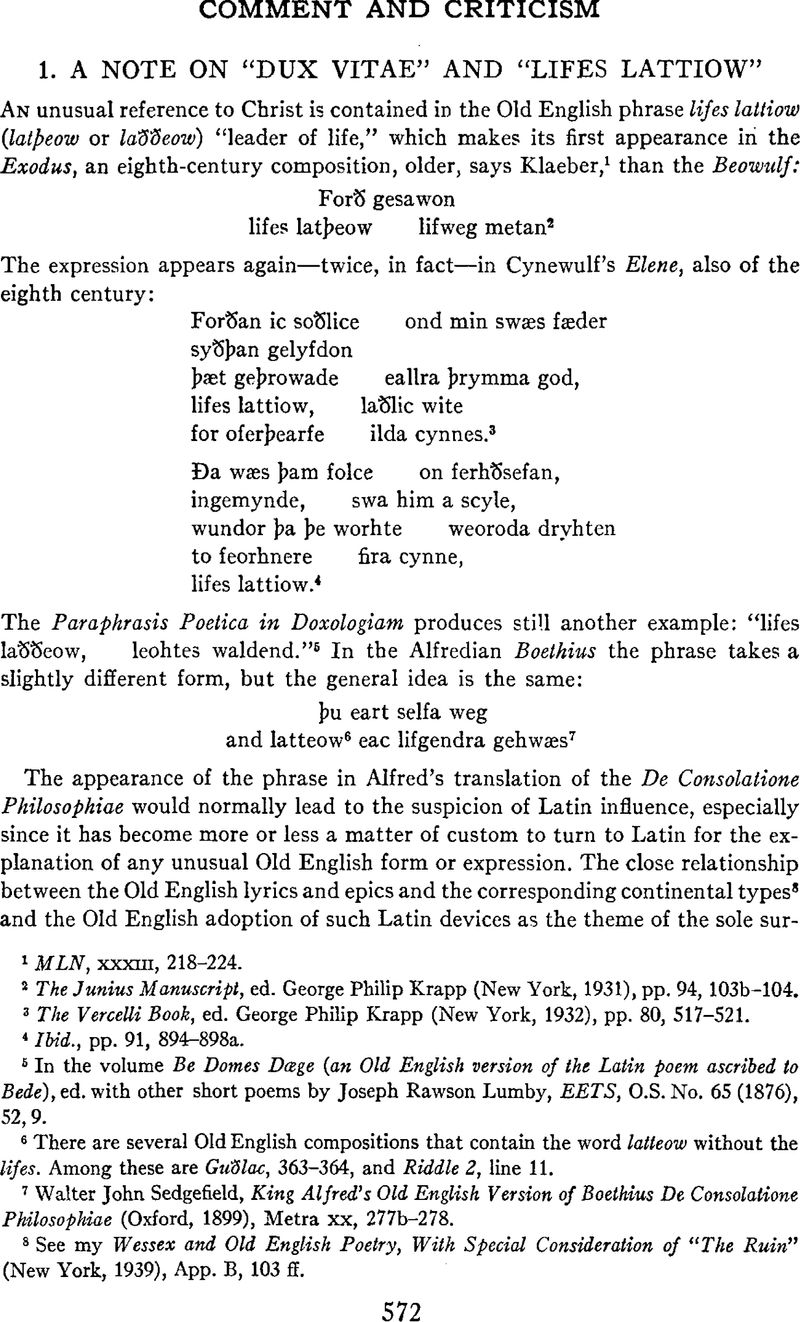No CrossRef data available.
Article contents
A Note on “Dux Vitae” and “Lifes Lattiow”
Published online by Cambridge University Press: 02 December 2020
Abstract

- Type
- Comment and Criticism
- Information
- Copyright
- Copyright © Modern Language Association of America, 1942
References
Note 1 in page 572 MLN, xxxiii, 218–224.
Note 2 in page 572 The Junius Manuscript, ed. George Philip Krapp (New York, 1931), pp. 94, 103b–104.
Note 3 in page 572 The Vercelli Book, ed. George Philip Krapp (New York, 1932), pp. 80, 517–521.
Note 4 in page 572 Ibid., pp. 91, 894–898a.
Note 5 in page 572 In the volume Be Domes Dœge (an Old English version of the Latin poem ascribed to Bede), ed. with other short poems by Joseph Rawson Lumby, EETS, O.S. No. 65 (1876), 52, 9.
Note 6 in page 572 There are several Old English compositions that contain the word latteow without the lifes. Among these are Gu⊘ac, 363–364, and Riddle 2, line 11.
Note 7 in page 572 Walter John Sedgefield, King Alfred's Old English Version of Boethius De Consolatione Philosophiae (Oxford, 1899), Metra xx, 277b–278.
Note 8 in page 572 See my Wessex and Old English Poetry, With Special Consideration of “The Ruin” (New York, 1939), App. B, 103 ff.
Note 9 in page 573 The significance of the phrase in pre-Christian literature, in the works of Lucretius, Cicero, and Sallust, representatives of the two great philosophical schools, will be discussed in a future paper.
Note 10 in page 573 Harry Bresslau, “Die Werke Wipos,” in Wiponis Opera. Dritte Auflage (Hannover und Leipzig, 1915), 65, line 3.
Note 11 in page 573 Ibid., 65. Wipo died c. 1050.
Note 12 in page 573 F. J. E. Raby, A History of Christian-Latin Poetry from the Beginnings to the Close of the Middle Ages (Oxford, 1927), 217.
Note 13 in page 573 It is interesting to observe that the phrase does not appear in the Vulgate.
Note 14 in page 573 References to Christ as dux are plentiful, but it is the combination of dux and vitae that is unusual.
Note 15 in page 573 Guido Maria Dreves, Analecta Hymnica Medii Aevi, l (Leipzig, 1907), pp. 325, No. 251, 9. Raby says of this poem that in some lines Othlo “expands, in a curious exercise of imitation, the Victimae Paschali of Wipo....” Op. cit., p. 224.
Note 16 in page 573 Raby, op. cit., p. 315.
Note 17 in page 573 One of the fifteen “Rhythms” that make up his famous Mariale, a long and unusual poem in praise of the Virgin. Raby, p. 318.
Note 18 in page 573 Dreves, op. cit., p. 462, verse 5.
Note 19 in page 573 Raby, op. cit., pp. 421 f.
Note 20 in page 575 Dreves, op. cit., pp. 571, No. 383, 1 ff.
Note 21 in page 575 Dreves, op. cit., viii (Leipzig, 1890), 55, No. 58, verse la.
Note 22 in page 575 Ibid., 33, No. 30, verse 10a.
Note 23 in page 575 Gustav Ehrismann, Geschichte der Deutschen Literatur (München, 1918), i, 376.
Note 24 in page 575 Othlo wrote a life of St. Boniface (the English Wynfrith), who established the bishopric of Regensburg in the eighth century.




